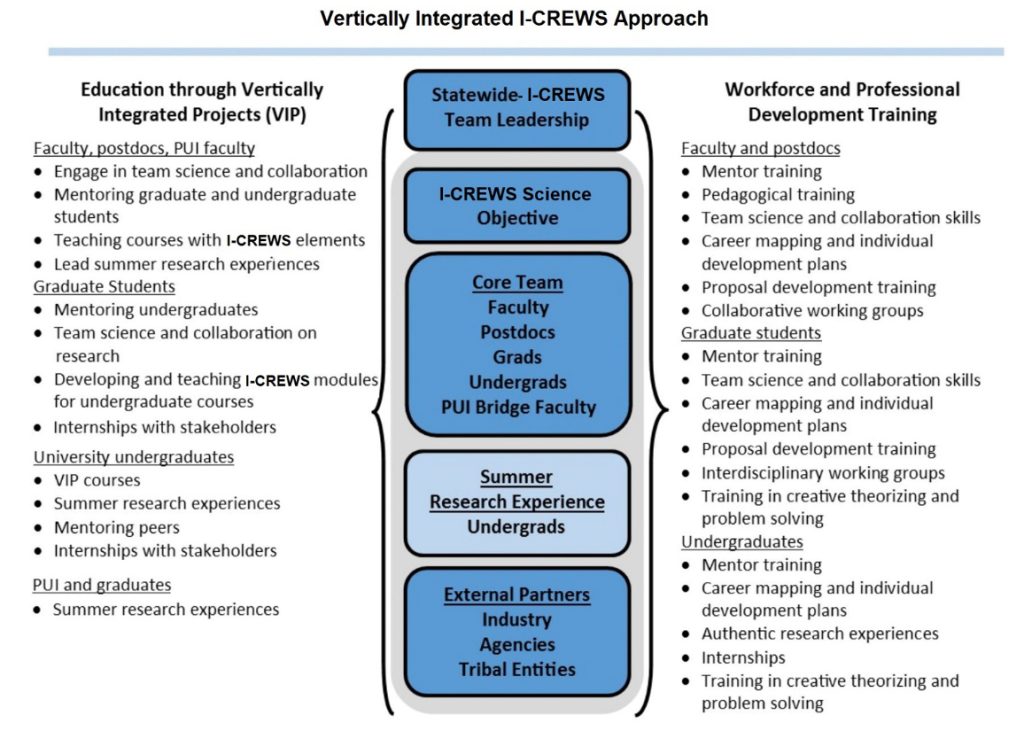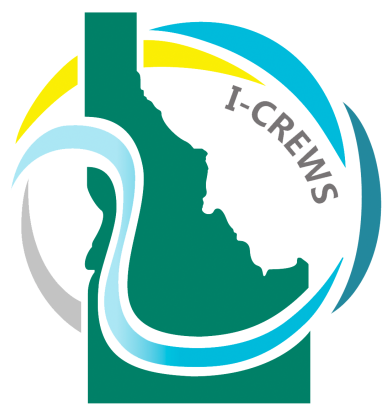Education
Overview
The overall goal of the I-CREWS Education and Workforce Development plan is to develop individual, community, and institutional capacity for more resilient and equitable futures with respect to education and E-W systems. I-CREWS builds capacity and implements programs at levels spanning K-12, through graduate education, to faculty. Activities will build the necessary skills for leadership and democratic participation in equitable E-W systems through internships, coursework, and teacher professional development.
Community Integrated Programs (CIP) are courses offered to community members, undergraduate and graduate students, co-created around community-identified priorities, to address E-W systems issues. CIPs engage learners across disciplines (e.g., across STEM, policy, and law), knowledge systems (e.g., local and Indigenous knowledge, academic knowledge), and bridge between the community and academic institutions. Community, students, and faculty together learn with each other as they imagine more equitable interdisciplinary solutions to complex E-W issues.
In continuation of previous education efforts within the GEM3 program, I-CREWS is continuing to use a Vertically Integrated Projects (VIP) strategy. The VIP is an intentional curricular infrastructure that establishes an on ramp for students and provides a range of training, mentoring and professional development support to both students and faculty. The VIP is implemented statewide and the goal is to provide the scaffolding to support transdisciplinary science and grow the next generation of conservation science leaders and workers.

How to Get Started
If you are a student interested in research, please visit the links below to see details on VIP research going on at your institution.
[ VIP Links will be available in Fall 2024 ]
Who should apply?
The VIP program is suited for students interested in working on teams, learning new tools and from the majors, including but not limited to, listed below:
- Artificial Intelligence
- Biological Sciences
- Computational Modeling
- Geosciences
- Interdisciplinary Studies
- Machine Learning
- Physics
- Resilience Science
- Social Sciences
VIP contact information
Boise State University: Donna Llewellyn, Jim Fredericksen
University of Idaho: TBD
Idaho State University: TBD
Idaho 2-yr and 4-yr Colleges: TBD
The I-CREWS Diversity Plan aims to increase participation from underserved populations (primarily Hispanics and Native Americans), low-income, rural and/or first generation students, and women, through diversity programs and outreach to regional Tribes, Hispanic communities, and rural communities. Increased public scientific literacy will be achieved through the engagement of citizen scientists and communities. Agency, industry, and tribal stakeholders will participate in scientific data exchanges, inform research questions, and provide internship opportunities.
Faculty Diversity
A more inclusive and diverse faculty will be promoted on I-CREWS campuses, improving recruitment, retention, and advancement of URM and female faculty.
Translation will be emphasized throughout the I-CREWS project to reach diverse audiences and to engage communities in ways that are aligned with the Education and WFD activities. The centerpiece of this work will be Project SCIENTIA.
Project SCIENTIA is an initiative that seeks to translate and disseminate scientific discoveries with a broad audience of Spanish speakers. 21% of the population in the United States speaks a language other than English, and 13.5% of that population speaks Spanish. In Idaho, 8.2% of the population is Spanish-speaking. Furthermore, worldwide, Spanish is spoken in 21 countries. Therefore, communicating science in Spanish is essential to building a society that is aware of the environment in an inclusive and diverse way. The objective of Project SCIENTIA is to create science, technology, engineering and mathematics (STEM) dissemination materials aimed at Spanish speakers in the United States.
